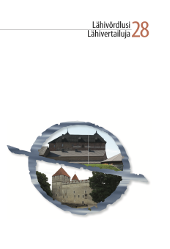Rajakarjalaismurteiden kielikontaktit venäläiskopioiden taajuuden ja fonologian valossa
Language contacts of Border Karelian dialects in the light of frequency and phonology of Russian copies
Author(s): Susanna TaviSubject(s): Language studies, Phonetics / Phonology, Lexis
Published by: Eesti Rakenduslingvistika Ühing (ERÜ)
Keywords: contact linguistics; corpus linguistics; copying; lexicon; phonology; Border-Karelian; Finnish; Russian;
Summary/Abstract: This article presents a corpus- and usage-based study on the contacts of Border Karelian dialects from the point of view of Russian-origin words (copies, in Lars Johanson’s terminology) and their phonological features. Te aim of the study is to describe the contacts between Border Karelian, i.e. partly mixed Southern and Olonets Karelian dialects, Finnish and Russian by comparing the dialects of six parishes as reflected in the synchronic spoken-language corpus of Border Karelian. Te dialects of Border Karelia were spoken until World War II in the easternmost part of Finland. They are distinguished from other varieties of Karelian by the strong influence of Finnish; this began already in the 17th century, and strengthened after 1944, when Border Karelia was ceded to the Soviet Union and its inhabitants were resettled in other parts of Finland. Te material of the corpus of Border Karelian has been recorded after the resettlement, from informants who no longer lived in their original home regions. Te study focuses on Russian copies that are a conventionalized part of Karelian and do not occur in Finnish. Te statistical tests indicated that differences in the frequencies of these words are statistically significant between the original parish dialects; the easternmost dialect has the most Russian copies, and the number of copies decreases from east to west with each successive parish. The results confirm the general hypothesis of Finnic language varieties as a continuum, on which the effect of Russian gradually grows as one moves east. Te continuum is geographical, and thus Olonets Karelian dialects do not have more Russian copies than Southern Karelian dialects, opposite to the assumptions. Accordingly, the results of the phonological analysis show that features which deviate from the phonotactics of Finnish are most frequent in the easternmost dialects and rarer in the west. Te features of vowels indicate that all Border Karelian dialects have had intense contact with both North Russian dialects and Standard Russian. In conclusion, the lexical and phonological impact of Russian on Border Karelian, increasing gradually from west to east, can be detected in the speech of Border Karelian informants even two decades after their resettlement to a Finnish-speaking environment.
Journal: Lähivőrdlusi. Lähivertailuja
- Issue Year: 2018
- Issue No: 28
- Page Range: 316-356
- Page Count: 41
- Language: Finnish

